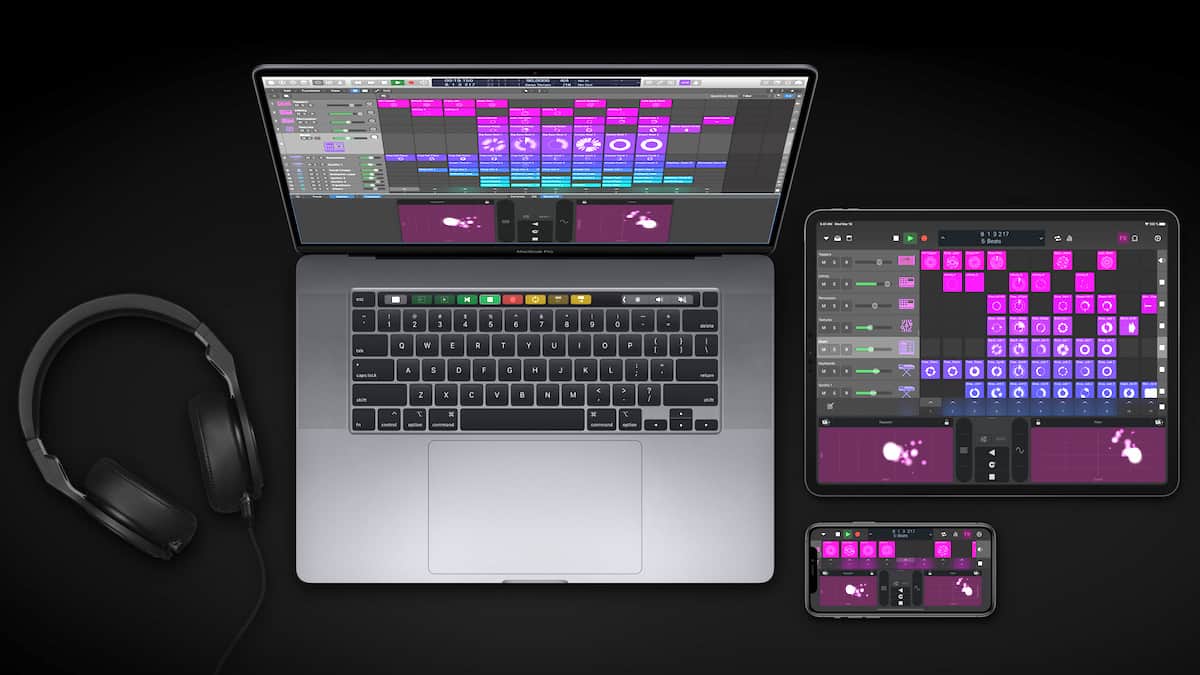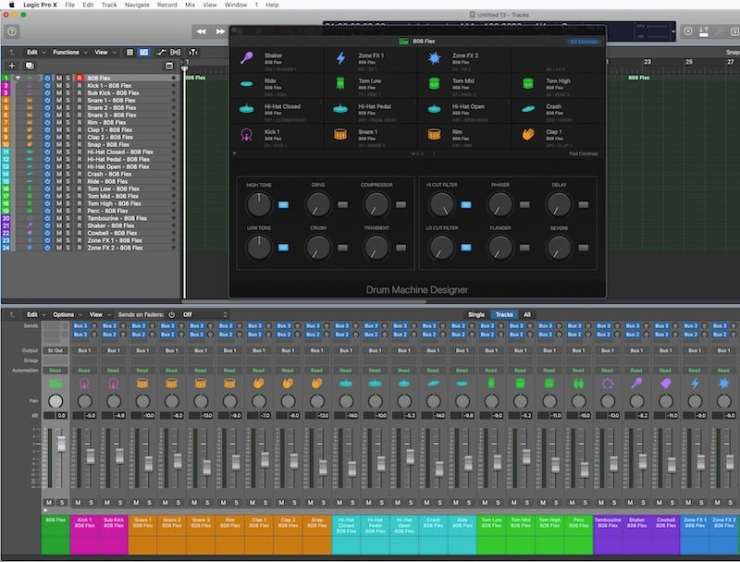DAW
Apple Logic Pro X 10.5 Review

What are the most exciting new features in the latest Logic Pro X update?
Version 10.5 is probably the most significant update since the introduction of Apple’s flagship DAW for creative professionals, Logic Pro X. It has something for everyone, from more traditional composers to EDM, hip-hop, and DJ producers. We have a lot to cover, so let’s begin with a look at the new trio of samplers.
Sampler
Sampler is a new Logic plug-in that completely replaces EXS24. You’ve certainly heard the saying, “A picture is worth a thousand words.” Here we see how drastically Apple has transformed our beloved but long-in-the-tooth EXS24 into something new.

What Logic Pro X’s sampling plug-in does and how it works under the hood hasn’t changed drastically. As you can see, though, Sampler is broken into panes that are easier to access than in EXS24. The Modulation Matrix is much easier to grasp, and the Synth pane is sleeker. Creating a Sampler instrument by importing samples and mapping them into zones no longer requires opening the Instrument Editor, which was always a painstaking process.

My biggest disappointment is that Sampler doesn’t yet support true legato instruments or Kontakt-style scripting. If your default was to select an existing EXS24 instrument when possible because it put less strain on your computer, then Sampler will not change that for you.
Quick Sampler
Quick Sampler is my favorite new feature. It is fast, useful, and integrates with Sampler beautifully. Easily create new instruments by dragging and dropping Apple Loops or other audio files into Quick Sampler and then editing them. Importing any audio file creates a new region that is bounced offline rather than audibly in real time.
You have the option to choose whether your imported sample is Original or Optimized. Original retains the source audio’s loudness, tuning, looping, and length. Optimized analyzes the audio and then, if needed, adjusts its loudness, crops out silence, and corrects any tuning errors. The process then identifies loop points and inserts crossfade markers, often improving how the loop sounds. Whether you choose Original or Optimized will probably depend on how well you’ve edited the source audio. I doubt that choosing Optimized could ever do any harm, though.

Once you’ve imported a sample, you can choose from three playback modes:
Classic mode plays the sample for as long as you hold the key. It’s great for starting and stopping on the fly to create stutter effects.
One Shot mode plays the sample all the way through, even if you release the key. As you move up the keyboard with these two modes, the tempo gets faster. No worries, though—inside Quick Sampler is the familiar Flex icon. It turns on Follow Tempo so that its play rate chases your project tempo, even if it’s 1/8 or 8 times as fast.
Slice mode cuts the sample into slices and maps them so you could play them on a keyboard. I’m most excited that you can export the Quick Sampler slices and use them to create a Drum Machine Designer kit. I had a lot of fun dragging audio into Quick Sampler with Slice to create playable DMD kits. They didn’t even have to be drum sounds.
The Recorder button lets you record audio directly into Quick Sampler, making it function more like a traditional hardware sampler. Simply connect a microphone, press the Record button, and then record vocals, hand claps, shaker, more cowbell, kazoo, or whatever else you want, and voilà, you’ve created a playable instrument. Quick Sampler gives you most of the same controls as Sampler for changing LFO, pitch, filter, and amp parameters.
Of course, you can not only save all your parameter changes, but you also can save everything in Quick Sampler as a Library patch that you can open in Sampler.
Auto Sampler
If you were a Redmatica user, then you’re well familiar with Auto Sampler. Apple bought the Italian software developer Redmatica in 2012 and hired its brilliant lead programmer. After Auto Sampler eventually made its way into MainStage, many assumed it was only a matter of time before it found its way into Logic, too. At long last, now it has.

Do you have any sounds from MIDI instruments you’d love to convert to playable Sampler instruments? Or do you have a sampler library, but you don’t need every keyswitch in every patch, only a few bread-and-butter samples? In either situation, Logic Pro X’s new Auto Sampler has you covered.
Auto Sampler is a Logic Audio FX plug-in that lets you create new Sampler instruments by sending MIDI commands to an external instrument and sampling as many notes at as many velocities as you specify. You can choose the pitch intervals between samples, the number of velocity levels and round robins you want, and a variety of other parameters before sampling begins. The greater the range and the more detailed the instrument is, the longer automatic sampling will take. My only fear about this featur? I could spend so much time sampling everything in my studio that I won’t have any time left to make music.
Step Sequencer
For years, Logic Pro X users have bombarded Apple with requests to add a step sequencer. With the addition of Step Sequencer, Apple has finally granted their wishes. You turn steps on and off in a step grid with patterns that are from 12 to 64 steps long. You have total control over individual settings such as step length, velocity, and playback mode in individual rows and even individual cells. Step Sequencer offers Note rows, a Melodic row, and Automation rows. The rows even have subrows for automation and editing. Logic Pro X saves all your choices within each pattern you save. You can save and recall patterns and create templates in the Pattern Browser.

What’s more, the Loop Browser now features Pattern Loops.
If you’ve been longing for easier step sequencing, the new Step Sequencer may be just what you’ve been waiting for.
Live Loops
If you’ve used Ableton Live, you’re familiar with the concept of creating music by triggering cells in a grid using samples, loops, and audio clips. Now Logic Pro X gives you similar functionality by letting you assign loops and other audio files—even software instruments—to Cells and Scenes you can trigger in real time. You get precise control over their start points, quantization, and other attributes. Once you’ve practiced a performance, you can record it into the Tracks area to capture it, or just leave it live in the Live Loops Grid.
Apple has updated Logic Remote to work with Live Loops on your iPad or iPhone. In addition to Phat FX and Step FX, you also get new DJ-style Remix FX designed to work with Live Loops.

As a more traditional songwriter and composer, I probably won’t use Live Loops very often, but it could be the most exciting new feature for many Logic users.
Drum Machine Designer Makeover
Apple has totally reworked DMD. Instead of building it around Ultrabeat, all the kit pieces are now in Quick Sampler. It’s crazy easy to do things like dragging and swapping out samples, changing any sound, creating melodic parts, or assigning a software instrument to a pad. It also has a new Drum Synth for entering Drum Machine Kit piece sounds in real time.

And the Rest
In addition to everything I’ve mentioned above, Logic Pro X 10.5 comes with Starter Grids and excellent tutorials for Live Loops. It furnishes tons of new Apple Loops content, with more genres and sub-genres than ever. It also has more than 70 new DMD kits, 1,500 new Library patches, support for using Live Loops with the Novation Launchpad series, and plenty of new and useful key commands. The list of improvements and enhancements goes on and on.
Perhaps the most unexpected new content is an original multitrack project containing Billie Eilish’s song “Ocean Eyes.” It’s surprisingly simple, but it sounds terrific.
If you haven’t yet downloaded the latest 10.5 update (version 10.5.1), you shouldn’t wait a moment longer. You’ll be glad you did.
Website: apple.com
Price: $200 (90-day free trial); free update for all current owners
-

 In This Issue4 weeks ago
In This Issue4 weeks agoNative Instruments Kontakt 7 Is Now Compatible With macOS Sonoma
-

 Covers3 weeks ago
Covers3 weeks agoImage-Line FL Studio 21.2.3: the Synth and Software review
-

 In This Issue3 weeks ago
In This Issue3 weeks agoNew From Orchestral Tools, Monolith by Richard Harvey
-

 In This Issue2 weeks ago
In This Issue2 weeks agoNew Chromaphone 3 and AAS Player Plug-ins







